Displaying items by tag: Peter Malone's Movie Reviews
Niente di Serio/ Nonnas on the Run
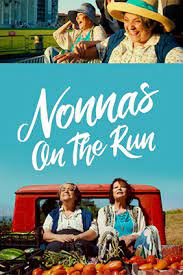
NONNAS ON THE RUN
Italy, 2018, 94 minutes, Colour.
Claudia Cardinale, Nunzia Schiano, Jordi Molla, Daphne Scoccia, Ilenia Pastorelli, Eduardo Pesce.
Directed by Laszlo Barbo.
Nonna is an affectionate Italian word. It means grandmother. And this English title is an enjoyable play on the British comedy title, Nuns on the Run. However, as is seen on a final gravestone, the Italian title indicates nothing serious!
This film is a romp, often quite over-the-top in its exuberance. Many commentators have made reference to Thelma and Louise, but this time the two ladies on the loose so to speak, are in their 70s, living in aged care, feeling the confines, wanting to escape and contriving to set up two of the carers, encouraging their relationship, distracted, so that they can get out of the building.
Claudia Cardinale plays the Duchess, a gambler, and alienate it son who is an orchestra conductor, about to return to Italy in Venice. Nunzia Schiano is a widow who was a top cook at a restaurant. Her daughter, married again, has control over her money. Her granddaughter is rather wild, alienate it from her mother, complicit with her grandmother in the escape and later following her.
There are all kinds of comic adventures, especially in the initial encounter with two gay transvestites, just after they are suddenly robbed of all their money. (And there are schemes of them to get their way, the transvestites being seductive to bank managers and others and photographing them when compromised.)
There are adventures in Rome. They travel to Pisa, even having a ride there in supermarket trolleys. They are on the road, have great success in getting money in gambling, later stolen, and much of it lost at another casino. They encounter a farmer who hosts them, drives them, despite a breakdown, to Venice.
Meantime, the two nurses are in trouble, fired, but continue their relationship.
The young daughter encounters the transvestites who get into trouble with the police, accused of kidnapping the grandmothers. One of them is interned. The other, played by veteran Spanish actor and author, Jordi Molla, has a long journey, often clashing, with the daughter, eventually arriving in Venice.
There are various moods along the way, the Duchess exuberant, the widow having second thoughts and longing for her husband, the pursuing couple trying to avoid the police, eventually arriving for the recital of the widow then collapsing. (But not before she is given a severe talking to her granddaughter getting to reconcile with her mother.)
Older audiences can identify with the two grandmothers and their run. And it is challenged to younger audiences, middle-aged and young, to give more thought and attention to the elderly.
Five Nights at Freddy's
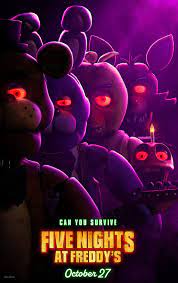
FIVE NIGHTS AT FREDDY’S
US, 2023, 110 minutes, Colour.
Josh Hutcherson, Piper Rubio, Elizabeth Lail, Matthew Lillard, Mary Stuart Masterson, Kat Connor Sterling.
Directed by Emma Tammi.
For this reviewer, a good surprise. For diehard horror fans, strong expressions of disappointment. They wanted more shocks, more scares, more gore. They were not impressed by the human story.
Five Nights at Freddy’s is based on a computer game, popular since 2014, by Scott Cawthorne who contributed to the screenplay for this adaptation of his game. Box office and some blogging indicates that many fans of the game have enjoyed the film.
Rather than set up expectations for it as a horror film, it is probably best to call it a “terror film”. While horror has been a staple of the prolific Blumhouse production company, in more recent times, as with The Black Phone, there have been quite a number of menace and terror dramas, more accessible to a wider audience.
The screenplay for Five Nights keeps a favourable audience quite involved. There are some moments of horror at the opening, but then an introduction to a troubled young man, Mike (Josh Hutcherson), traumatised by the abduction of his younger brother, inadequately caring for his younger sister (with their aunt, Mary Stuart Masterson, wanting custody to get the payment checks). He is interviewed by a career counsellor who recommends a job as security at an abandoned restaurant, popular with families, but now in disrepair. This is Freddy’s.
For audiences who are interested in the family drama, this is followed through in some detail, but made more complex by Mike reading a book Dream Theory and having, throughout the film, a recurring nightmare, revisiting the abduction of his brother, each dream adding more as Mike tries to discover who took his brother. This dream thread is often quite powerful.
As regards Freddy’s, there are five very large Animatronic characters (from Jim Henson’s workshop), rather than computer graphic effects, who come alive, repeating a song and dance routine from the past, but also can be terrifyingly menacing. We see them in action against some thugs, urged on by the aunt, to trash Freddy’s. But we also see them engaging happily with Mike’s sister, (Piper Rubio). There is also a sympathetic policewoman (Elizabeth Lail) on watch who befriends Mike, giving him advice.
Of course, it will build up to quite a confronting climax, and some revelations about the villain behind Freddy’s, about the policewoman, which a number of viewers said they anticipated but, probably, most audiences will find it an interesting twist.
One note about the screenplay, there are only two coarse words uttered throughout the whole film, no reliance on repeated coarseness, one word spoken by the main thug, the other by a pharmacist who has been offended by Mike.
As expected, at the end, there are questions raised about the future – indicating possible sequels.
- The popularity of the computer game? Since 2014? Accompanying merchandise? The age of the players?
- The atmosphere of the town, public places, homes and apartments, offices, and the contrast with the isolated Pizza rear, the facade, the parking, the range of dim interiors? The musical score?
- Willing suspension of disbelief? Characters, ghostly appearances, abductions, the animatronic animals, coming alive?
- The description of the film as horror – or, rather, it being a terror and menace film? Some scares, some touch of the grizzly, but more the atmosphere of terror? Popularity of the box office, some critics wanting more horror?
- Freddy’s, in the past, for pizza, entertainment, the animal characters, children and families? The accusation about the owner, the pizza rear in decline? Need for security guard?
- The introduction to Mike, the memories of the past, his family, his brother, the picnic, his brother’s disappearance, Mike blaming himself, but very young? The consequences, his insecurities, wanting to find out what happened, his continued dreams, the developments in the dreams, re-enactments, questioning the mysterious children?
- Mike, his friend, interpreting the man abducting a child, attacking him, punching him? His going to the job counsellor, not able to hold down a job, the lecture by the counsellor, the offer of the job – and the ironies of the final revelation about the counsellor?
- Mike, with Abby at home, the tension between them, her drawings, his presence? His sister? Memories of the parents? The relationship with their aunt, her wanting control, and the support money, the confrontations with Mike, the thugs, urging them to rough up the pizza rear, the aftermath? The irony of the babysitter, connection with the group, Mike relying on her during the night shifts, her being part of the gang?
- Freddy’s, the atmosphere, the old machines, the lights, the animatronics? Sounds? Suspicions? The surveillance, cameras, the lights?
- The policewoman, surveillance, discussions with Mike, supporting, warning? A character, bonding with Abby? The visits to Freddy’s? Abby and her assertion? Mike’s apprehensions? The policewoman and her warnings, and the final revelation as to who she was, her father, and the final dramatics?
- The horror in the pre-credit sequence, the man, the tunnels, menace, his death? The thugs, their smashing the place, the creatures coming alive, the pursuit, the terror, menace, the horror of their deaths? Concealed, later discovered?
- Mike, the continued dreams, wanting to know the truth? The challenge in his dream, letting his brother go, his regrets?
- The buildup to the climax, the creature, menace, turning on the family, the irony of the father, the abductions, the trapping of the children, in the creatures, his control over them? His daughter, Mike, Abby and his defeat? The irony of it the revelation of who he was?
- The screenplay and the combination of Mike’s story, the abduction, his search, the consequences for him, Abby? His dreams? Along with the horror story about the haunting of Freddy’s?
Scarygirl
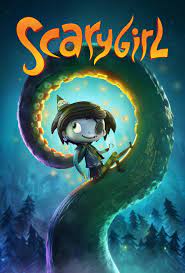
SCARYGIRL
Australia, 2023, 90 minutes, Colour.
Voices of: Jillian Nguyen, Sam Neill, Rob Collins, Tim Minchin, Anna Torv, Liv Hewson, Remi Hii, Mark Coles Smith, Deborah Mailman, Kate Murphy, Dylan Alcott.
Directed by Ricard Cusso, Tania Vincent,
In fact, Scarygirl is not scary in herself, just initially scary to look at. She has been the subject of games, books, dolls and merchandise, created by artist Nathan Jurevicius.
For audiences not familiar with Scarygirl, this is an Australian production, Australian animation, directed by Ricard Cusso who has a number of animation films to his credit, and Tania Vincent, responsible for the direction of the animation. Looking back over Australian cinema history since the 1970s, there has been a strong tradition of animation films and, especially, on television (think Bluey).
The animation style here is quite idiosyncratic. The backgrounds are vivid, bright colours, very busy in detail, high on technological aspects. We are in another planet, a mad scientist and his experiments, control of the sun, wanting to reanimate characters, especially his lost daughter. And there are quite a number of sinister characters, many of whom have comic touches. There is the black-dressed rather sepulchral The Keeper. There is a chattering rabbit, Bunniguru,, and his associate, Egg, the rabbit an inveterate gambler, who owes a great deal to a small moustachioed villain-henchman, Chihoohoo, who is on a mission to capture a life-giving octopus, Blister, who cares for Scarygirl.
Quite a lot of adventures, the capture of Blister, Scarygirl wanting to rescue her father, encountering the mad scientist, but finding quite a number of allies in this strange world, building up to the expected confrontation, rescue, and Scarygirl being a determined action hero.
It would be very interesting to hear children being interviewed after watching the film, its impact on the littlies, primary school children, on secondary students – how much they followed, how much they enjoyed the film, what it meant to them. There is enough here to interest adults accompanying the young audience.
And, there is the huge attraction of the voice cast, the mad scientist, Dr Maybee, by Sam Neill, Chihoohoo by Tim Minchin, Blister by Rob Collins, The Keeper by Anna Torv – and, most important for the film, Scary girl voiced by Jillian Nguyen.
- The title? The girl, her appearance and being scary, her background and her creation, destruction, reappearance?
- The nature of the animation, Australian creativity with European background, complex, the world, the technology, the locations, laboratories, and the design of all the characters? Human, semi-human, animals…? In the musical score?
- The basic story, the planet, the son and its energy, the story of Dr may be, the mad scientist, his daughter, death, animosity towards Blister, channelling the son? Wanting to recreate his daughter? The final confrontation, Blister, Scary girl, his defeat?
- The situation with Blister, confronting Dr Maybee, exile, caring for Scary girl, father figure, octopus and his talents, creativity? His being captured, the buildup to Dr may be?
- The other characters, Chihoohoo, small, the touch of the gangster, is allies, the mission to capture Blister?
- Bunniguru and Egg, their partnership, friendship, the gambling, in debt, paying off his debt by the capture of Blister?
- The sinister presence of The Keeper, in black, female? The final revelation of who she was, against Dr Maybee, collaborating with scary girl and the confrontation?
- The range of adventures, the characters, scary girl and her forthrightness, abilities, Blister, and the support of bunny girl, and mending Egg?
- The impact for the range of audience, very young, young, teenage, adults?
Ombra di Caravaggio,L'/ Caravaggio's Shadow

OMBRA DI CARAVAGGIO, L’/CARAVAGGIO’S SHADOW
Italy, 2022, 120 minutes, Colour.
Riccardo Scarmachio, Louis Garrel, Isabelle Huppert, Micela Ramazotti, Tedua, , Michele Placido, Vinicio Marchoni, Lolita Chammah,Nadia, Brenno Placido, Gianluca Gobbi, Gianfranco Gallo, Michelangelo Placido, Moni Ovadio, Gianluca Gobbi, Gianfranco Gallo.
Directed by Michele Placido.
Every person casts their own shadow. Celebrated 16th-17th century Italian painter, Michelangelo Merisi, best known as Caravaggio, certainly cast a long shadow, in his low life in the slums of Rome and beyond, in the world of art in his own time, in his artistic heritage. However, all that it is very evident in this portrait of Caravaggio. But the “Ombra”, “Shadow” of the title refers to the agent of the Vatican, an Inquisitor, who is commissioned to investigate Caravaggio and provide a report about his life, his being charged with murder, to the Pope.
This portrait is in pieces, something like jigsaw pieces, visualised for the audience, highly dramatic, not in chronological order, moving backwards and forwards in time, many flashbacks, providing the audience with images and insights for them to finally put together all these pieces for some kind of understanding and appreciation of Caravaggio, his character, his behaviour, his art, his and morality and yet a moral sense and religiosity, a genius and an opportunist.
The film has been cowritten and directed by veteran actor, Michele Placido, who also appears as a patron of the artist, Cardinal Del Monte. Caravaggio himself is played by internationally known and popular Italian actor, Riccardo Scarmacio, often a dark and brooding presence, complex, content in the underbelly of Rome, happy with the Regal patronage, especially from the Marquesa Colona, played by Isabelle Huppert always speaking dialogue in French, contacts with cardinals, unreliable, moody, sexually profligate, but with an innate sense of the Jesus of the Gospels, appreciation of the gospel narratives and a burning desire to re-create them in his art.
The Shadow of the title is played by French actor, Louis Garrel, always convincing in serious roles, less so in light or comic roles, but perfect here in the relentless investigator, ambitious, single-minded, even rigid as regards doctrine and ecclesiastical order, who pursues his investigation, personal interrogations, resorting to water torture, interviewing the prostitutes and vagrants with some disdain, unafraid in challenging the nobility, finally a confrontation with the artist himself. This is a frightening portrait of an ecclesiastical Inquisitor, admiring the works of art, but unhesitatingly condemning the artist for his life.
Set design and costumes and decor are marvellously portrayed to re-create the period, immersing the audience, especially in the low life of Rome. And, so many of Caravaggio’s paintings are brought to life, the finished works as well as the process of choosing the models, set-ups and posing, the artist and his work of painting. And the lighting of the film evokes the chiaroscuro light and darkness of the works at the beginning of the baroque period.
Riccardo Scarmacio plays Caravaggio with all his faults, sins, but with a deep innate sense of admiration for the Gospel stories, evoking audience sympathy for him, no matter what. And, he notes that in his choices of prostitutes as models for portraying Mary, the mother of Jesus, and himself, after his throat is slashed by the vengeful brothers of the man Caravaggio fought in a duel and killed, the right choice for the image of Goliath. And some of the prostitutes themselves, exploited and persecuted, note that being chosen to portray Mary was a highlight of their lives.
Evocative, interesting, taking us back into a complex period of church history, with some interesting sequences featuring Giordano Bruno, burnt at the stake as a heretic, the young artist, Artemisia, and St Philip Neri of the Oratory, seen sympathetically in the midst of the hardships and squalor in which he ministered.
Evocative also in raising all kinds of questions about artists in their times, their moral lives and choices, the relationship of these choices to the quality of their art and achievement.
- An interesting and provocative visit to Italy and the baroque period? The world of Caravaggio?
- Audience knowledge of the painter, of the period, of the baroque, painting styles, chiaroscuro, the paint, the canvases, the choice of models, the posing…?
- Costumes, decor, the period, Rome, the papal court, the church, the underbelly of the slums? Naples and other Italian cities? Atmosphere? The musical score?
- The structure of the screenplay, moving around in time, end of the 16th, beginning of the 17th century? Dates and places? A Mosaic of scenes and sequences, the connections made, the audience making connections, references, and ultimately putting everything together?
- Riccardo’s Camacho as Caravaggio, a brooding presence, artistic genius, his background with the Contessa, religious background and religious sense, connection with the gospel stories? Poverty, at home in the low life of Rome, the beggars, the poor, the prostitutes, the sexual connections?
- The central situation for the film, point of reference, the murder? The audience eventually seeing the confrontation, the fight, the death – in the background of Caravaggio’s relationship with the brothers, in the dealings in the underbelly of Rome? Their vengeance on Caravaggio, stabbing his cheek and mouth? (And his deciding that his image was that for Goliath?)
- The role of the Pope, Rome ecclesiastical and secular, the condemnation of Caravaggio, the possibility for apartment? The Pope, meetings with the Cardinals, Cardinal Del Monte and his support of Caravaggio and his art, the Pope’s nephew and his dealings?
- The title of the film, the Inquisitor as the Shadow? Louis Goel and his presence, performance? Sinister? Dressed in black? Devotion to the Pope, his understanding of the church, doctrine, rigidity and traditionalism? His mission, the range of his encounters, interrogations, using water torture, violence? His discovery of Caravaggio’s art, the models, questioning, admiration of the art, yet condemning Caravaggio? Eventually meeting him, the setup, Caravaggio travelling, the sea, the attack, death? And the Inquisitor reporting finally on the mission accomplished?
- The Contessa, speaking French, her husband, her care for the young Caravaggio, the meetings with him, the discussions, her sensuality, sexuality, reputation? With the Inquisitor? With her son, his responsibilities, dealings, Caravaggio?
- The range of prostitutes, on the streets of Rome, the harshness, the men, sexual violence, exploitation, the young women, some standing their ground, children, pregnancy? Squalor?
- Caravaggio and the women, his relationships, over the years, their response to him, posing for the portraits, their being condemned for portraying the Virgin Mary? But this being an affirmation of their lives? And the status of the paintings and where they finished?
- A violent era, a religious era, an era of art and achievement? Especially in Italy, Rome? The range of Caravaggio’s paintings, the film highlighting them, the completed works, works in progress, models posing for them?
Sweet Sue
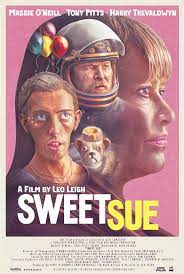
SWEET SUE
UK, 2023, 99 minutes, Colour.
Maggie O'Neill, Tony Pitts, Harry Trevaldwyn, Anna Calder-Marshall James Dryden.
Directed by Leo Leigh.
While Leo Leigh is a director and cinematographer in his own right, he has worked with his father over the years. Leigh is the clue. His father is Mike Leigh, distinguished filmmaker, writer and director of so many incisive socially-observed dramas for almost 50 years. Sweet Sue is in this vein.
The film is something of a social slice of life, introducing us to what we might call rather ordinary characters, difficulties in their lives, opening up of relationships, family complications.
We are introduced to Sue, a tour-to-force performance from Maggie O’Neill, middle-aged, lonely, at a restaurant, waiting, stood up by a phone call. She is a rather wilful character. However, her aged mother is in care (Anna Calder Marshall), her daughter trying to do her best for her – but not succeeding. Her brother is ill, confined to bed (James Dryden), soon to die. The brother seems to have had some bikie friends in his past, before his debilitation, and there are some strange characters at the wake and funeral. Sue is rather stoic in her reaction, criticised by her mother, catching the eye of a rather taciturn bikie, Ron (Tony Pitts) in leather gear and helmet, approaching him, taking off for a bike ride, but then an outburst of weeping in the woods.
Suddenly we are introduced to a somewhat bizarre character, Anthony (Harry Trevaldwyn), highly camp in manner and style, speaking to camera, an influencer, with an online clientele.
Time goes by, some months, Sue and Ron in a relationship, he breaking through some of his taciturn manner, she finding some satisfaction in the relationship. And, we are wondering, what about Anthony? We see him yet again, camp in style, dancing, talking to his clients. And then it turns out that he is Ron’s son.
So, as we follow the relationship between two middle-aged somewhat disillusioned adults, the drama veers into problems in a father-son relationship, and the intervention of Ron’s highly strident former wife who is in support of her son, promoting his group and their dance routine. Sue makes some adjustments, finds Ron’s reticence difficult to deal with, has a highly melodramatic confrontation with his ex-wife, tries to relate to Anthony, watches he is attempts to create a choreography and bursts into uncontrollable laughter. Very difficult consequences…
As with Mike Leigh’s films, this Leo Leigh film does not bring us ultimate solutions. The films are probing of characters, their feelings, their behaviour, clashes, friendship and love, and our wondering will these interactions be lasting or whether there will be new phases in the lives of these characters.
- The title and tone? The film is a slice of life? (And the work of the director and the influence of his father?)
- The settings, bars, homes, the countryside…? Characters at home in these settings? The musical score?
- The Sue and her story, middle-aged, at the restaurant, the phone call, stood up, upset, her visit to her mother, in aged care, her mother’s reactions, the mother wanting to see her son, Sue visiting Paul, his wife, his illness, debilitated, the family background and relationships? His death?
- The funeral, the mother’s grief, the wife, the visitors, Sue seeming unmoved, noticing Ron, approaching him, going for a bike ride, her weeping in the woods?
- Initial impressions of Ron, the bike gear, the helmet, silent, riding with Sue, the development of the relationships, over the weeks, the meetings, the sexual encounters, the effect on Ron? On Sue?
- Sue, her shop, the visitors, sense of play, the balloons, Sue and observing her customers…, Her changing the course of the relationship with Ron?
- The introduction to Anthony, age, style, manner, camp? An influencer, with his camera, his followers? His subjects? His coming to Ron, the revelation that he was Ron’s son, his continued work, the tensions at home, the encounter with Sue? His group, the dance contest, his working on his choreography – Sue Watson, laughing uncontrollably, his being upset? The tensions? The performance? But Sue taking the time to talk with Anthony, possibility of reconciliation? In the street, on the bridge?
- The scenes with Anthony’s mother, strident, in the street, the separation, her promoting his dancing, the performance, and the confrontations with Sue?
- Ron, his relationship with his son, taciturn, the meals, affecting his relationship with Sue?
- The slice of life, age, relationships, tensions, and future…?
Wife and Her Househusband, The
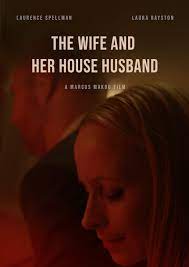
THE WIFE AND HER HOUSE HUSBAND
UK, 2023, 86 minutes, Colour.
Laura Bayston, Laurence Spellman.
Directed by Marcus Markou.
Marriage breakup and divorce proceedings have been significant for a great number of films. Ingmar Bergman made the telling Scenes from a Marriage (and there was the remake with Jessica Chastain and). There was also the contrasting Divorce His, Divorce Hers.
This time it is a very brief film, mainly a two hander, the wife Laura Based on, the husband Laurence Spellman, along marriage, some of the details gradually revealed as the couple have several meetings, opening with a fiery exchange, especially on his angry part, in the office of a lawyer, then a meeting in Battersea Park, an encounter on the street, a visit to a social club, masked, of which the wife is a member.
All the principal focus of the screenplay is on the wife, there is a continual challenge throughout the film of how much we identify with the wife, the more we learn of her experiences, how much we identify with the husband and what he has been through. Key to the breakdown is the experience of the death of a child 10 years earlier. Which makes the encounters, angry, hostile, sometimes affectionate, all the more complex.
At the core of the drama and its meeting is a letter that they wrote at the time of their marriage, the wife finding it, neither of them remember writing it, but now reading it, they’re specifying how they would handle any prospect of the marriage breaking down, of what they would need to do.
As the drama progresses, and the letter becomes more potent in their reactions to each other, there is a kind of mellowing, expressions of affection, the rousing of sexual attraction, an encounter, unexpected, in the park with a woman that the husband has been seeing and his having to go off to appease her.
And, as with so many films, no need solution, but, given our identifying/not with each of the characters, it is over to us to speculate, to keep wondering about the initial letter and the long-term effect of their reading it again, reconciliation or not.
- The title? The focus on the wife, and the relationship with the husband and his status?
- The British drama, the London settings, interiors, the bridge, restaurants, the club…? The musical score?
- The emphasis on dialogue, cinematic equivalent of theatre but opened out in outdoor sequences?
- The structure of the film, its brevity, the chapters, each character in the chapters, the cumulative effect?
- The initial impact, the meeting with the lawyer, Matthew and his shouting, strident, Cassie and her reactions, angry responses? The situation of the divorce? The children? Other relationships? The later revelation of the death of the child, the 10 years, the effect on each of them, Cassie disturbed and seeking other relationships? Matthew and the children, relationships? Conditions of the divorce, custody, time with the children? The lawyer and his presence, expensive, but not always paying attention?
- The meeting in Battersea Gardens, the setting, the discussions, the modification of moods, Matthew more amenable, Cassie more amenable? Matthew leaving, Cassie alone, the phone and the texting?
- The importance of the letter, written before their marriage, in the event of’s separation and divorce, how they would handle the situation? Neither of them remember in the writing of it? But its significance? They’re reflecting on it? And the effect of the reflections on each of them?
- The delivery of the documents, forgetting them? Further meetings?
- The club, Cassie’s membership, the clientele, the masks, Mathieu and his arriving, the encounter with Cassie, the journey to the bathroom, the sexual impulses? The consequences?
- The letter and its injunction to part with love, not bitterness, and what should be done to achieve this? The effect on the present, each following through?
- The suddenness of the AA meeting, Cassie and her presence, the encounter with Sean, the alcoholic and his influence?
- The mellowing between the two, the effect of having written the letter, finding it, pondering it, acting on it, what possibilities for the future?
Banlieusards 2/ Street Flow 2
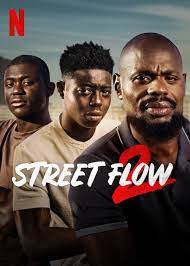
STREET FLOW 2/ BANLIEUSARDS 2
France, 2023, 93 minutes, Colour.
Kerry James, Mohamadou Coulibaly, Bakary Diombera, Kadi Diarra.
Directed by Leila Sy.
Street Flow was a commercial success in France in 2019, focusing on the particular suburbs of friends, enclaves because of race, poverty, social issues. This was highlighted in its French title, Bainlieuards.
This sequel appeared four years after the original but the timeline is only two years later.
The first film focused on three brothers, the oldest involved in the drug trade, violent, a drug Lord, imprisoned. The middle brother is the good brother, studying law, achieving his goals. The youngest brother is still at school, something of a rebel, missing his father, acting up and, finally, taking the blame for his middle brother holding a gun, spending some time in prison.
And, there is always the strong presence of their mother, from a migrant family from Senegal.
Now the three brothers are reunited, many home domestic scenes, the oldest brother, played by Kery James, rap singer, who has written the screenplays, now reformed and involved in business. The middle brother continues his success in law, dissatisfied with the office work, wanting to appear in court, eventually getting his chance, getting a guilty man off the charges, something his mother disapproves of. The youngest boy is still in trouble, at school, with gangs, but something of a genial personality.
Their mother dies and there is an outpouring of grief amongst the community. The family goes to Senegal for her burial, finds the school that she financed, in need of roofing and repair which the three brothers contribute to, working with the locals. Clearly, there is a message here, pressed home with some insistence, of the value of going back to roots and traditions.
The older brother has a possibility for some kind of redemption in a relationship with one of his workers but is continually tormented by the past and betrayals. The middle brother eventually appears on television, defending a woman against police brutality and arguing the social cases. The youngest brother learns some of his lessons, is urged by a teacher to read Jack London’s Martin Eden which eventually bring him to some greater awareness of himself and his potential.
- The impact of the original? Critical acclaim? Harsh criticisms? Significant social issues?
- The title, those who lived in the particular neighbourhood, the flow of the street? Enclaves in Paris, racial, poverty, social? Crime, police?
- The link with the original film, the story of the three brothers, troubles, crime, achievements? The absent father? The caring mother?
- The Paris settings, familiar from the first film, the home and apartments, school, business offices, the law? The musical score?
- Denba, two years later, being shot, recovering, going into business, his partner, asking for a raise and ousted from the car, the later double dealings? The official, the gift of the special box, demanding more money, cash, Denba’s revenge? The gangs, the drug dealing, the past, the connections, betrayals and shooting? And the bond between them, the revelation of his treachery, Abdel telling the story of the scorpion stinging the frog? Final revenge?
- Soulymaan, his studies, legal achievement, working the office, impatient with the files, discussions with the superior, wanting to appear in court, visiting the prisons, is chance, the guilty man, the fine points of law and the acquittal, telling his mother, her disgust? His reaction? His relationship with Denba? With his younger brother, care for him, not revealing the expulsion? His later career, defending Sofia’s mother and the police brutality, the television debate and the point she was making about society and law?
- Noumouke, age, his time in prison on behalf of his brother, at school, his music, listening, composing the lyrics, personal about his father? Late for school, surly, the fight in the classroom, expelled? His bond with his mother, the scenes at home? The bond with each brother? The teacher, urging him to read Martin Eden, reluctance, the story, gradually reading it, offhand, taking it to Senegal? The relationship with Sofia, the group on the bus, getting out, the bashing of the enemy, his having to escape, railing the crowds, the fight, Sofia firing the gun? Is not going home, finding his mother dead?
- The community response to the death, the sons and their mother, the gathering, grief? Going to Senegal, the family, the rituals, the burial? The issue of the school, her financing it? The decision to mend the roof, the collaboration of the whole community, the building, the roof, the painting? The reality of village life, simplicity, walking the hour to get the water, the whole community? The effect on each of the brothers?
- The return home, Denba and his revenge, the information, confrontations, shooting? The possibility of redemption, the relationship with the woman at work, the outings, the restaurant, her caution, her son, the final shooting?
- The lawyer and his success? The young man, talking with a teacher, the lessons he learnt?
- The film as drama? The film is social concern, characters dramatising social concern, their speeches? And solutions on the side of right, and going back to traditions?
Nimona
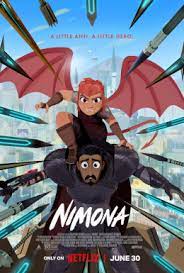
NIMONA
US, 2023, 11 minutes, Colour.
Voices of: Chloe Grace Moretz, Riz Ahmed, Eugene Lee Yang, Frances Conroy, Lorraine Toussaint, Beck Bennett, RuPaul, Nate Stevenson, Nick Bruno, Troy Quane.
Directed by Nick Bruno, Troy Quane.
This is an animated feature, geared for a more adult audience. It is based on a graphic novel by ND Stevenson. Part of the interest and intrigue of the film is its animation style, the backgrounds of knighthood in castles in something of the Arthurian vein, the range of characters and their depiction, but, especially, Nimona who is an exotic creature, a shape-shifter, young, energetic, serious but with a sense of humour, irony, coming to the rescue of a knight in distress, using all her shape-shifting talents (vividly visualised) in her quests, battles, achievements. She is voiced with emphasis on conviction by Chloe Grace Moretz.
To that extent, the narrative is something as expected. There is Ballister Boldheart (voiced by Riz Ahmed), a commoner raised into a Knight’s world, involved in battle, losing an arm (and getting a robotic replacement), involved in the death of the Queen, on the run, in need of saving, in need of reinstatement. And, Nimona is continually his saviour. The other principal character is an actual Knight, Ambrosia’s Goldenloin (Eugene Lee Yang). He has been in confrontation with Ballister but they reunited, a bond growing between them. And so, a range of adventures, shape shifting, final restoration.
However, the graphic novel and the film version have led to quite a number of discussions about identity, sexual identity, gender, transgender, same-sex love.
Nimona is something of a they rather than she. Nimona has elements of both boy and girl and can shape shift to either. There is also a queer subtext surfacing, the relationship between Ballister and Ambrosiaus, comradeship, affection, and then naming it as love.
(The writer of the original graphic novel ND Stevenson - who voices a character as do the directors - later came out as a trans-man.)
So, an adult animation film but also a dramatisation of contemporary gender identity issues.
Spa Night
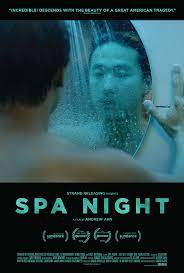
SPA NIGHT
US, 2016, 93 minutes, Colour.
Joey Seo, Haerry Kim, Tae Song.
Directed by Andrew Ahn
Spa Night it is a drama set in Los Angeles, within the Korean community, as well is in the wider city. It introduces us to a traditional family, seen at a family spa, washing. The film sketches the character of the mother and father, background traditions, interpreting them within an American context, the concern about their son, the father working hard to raise money for his son to go to college, the strong-minded mother concerned about her son’s future.
The film focuses on the son, played by actor Joey Seo, a teenager, feeling the strictures of the family traditions and his responsibility towards his parents, not committed to education as his parents hope, having interviews with the education head, accepting to study with the friend of the family is sung, but the sun leading a rather carefree and open life. While the teenager is caught up in this, he wants more.
The film is rather more subtle in its presentation of the teenager, his coming of age, his growing awareness of his sexual orientation but highly closeted.
In the chance visit to a spa, with the visuals of male nudity indicating his response, he applies for a job at the spa and is accepted. The manager of the spa is very strict, forbidding any sexual behaviour, wanting it reported.
However, there is activity, and the young man is prurient, looks, is somewhat repelled, talks to the manager – but, eventually, succumbs to the atmosphere, nudity and sexuality, and becomes involved with customers.
The story then is left to the audience to evaluate, wonder about the central character, his decisions, coming out, behaviour, his future.
Hermana Muerte/ Sister Death
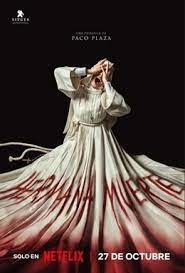
SISTER DEATH/ HERMANA MUERTE
Spain, 2023, 91 minutes, Colour.
Aria Bedmar, Maru Vladivielso, Luisa Merelas, Chelo Vivares, Sar Roch, Almudena Amor, Consuela Trujillo.
Directed by Paco Plaza.
Writer-director, Paco Plaza, has a strong reputation for films which include horror touches, horror themes. He was responsible for the Rec franchise.
In 2017, he wrote and directed Veronica, set in 1991, a 15-year-old girl in a Madrid school, caring for three younger siblings, her father dead and missing him, her mother always at work. At the core of the film is Veronica is longing for her father, having a session with a Ouija board with her school friends, horror consequences.
However, while the nuns teaching at the school are in modern dress, there is a very elderly sister, old-style habit, blind, looking sinister, with the nickname from the girls, Sister Death.
This drama, popular and with critical acclaim, is a prequel, focusing on a young nun in 1949, Sister Narcisa – who, ultimately will be seen in the final sequence, 1991, as Sister Death, played by the previous actress, Consuela Trujillo. Which means that this is a prequel to Veronica.
The film opens in 1939, snippets of black-and-white photography, a visionary, pious crowds, the little girl holding up a cross. The action then moves to 1949, memories of the Civil War with bullet holes in the convent walls, the convent now catering to educate young girls. Sister Narcisa arrives, very young, sweet, the touch of the angelic, perfectly embodied by Aria Bedmar. She is welcomed by ebullient superior and by the more restrained, Sister Julia. She is to teach the girls – with a class on eclipses which reminds audiences of the classes on eclipses in Veronica.
However, there is something sinister in her room, a sense of another presence, the chair falling, a wall sketch of the gallows. The girls are fidgety in class and the suggestion that one of them sees an apparition of a girl. The superior is cheery, Sister Julia becoming stern, disciplining the girls.
But, as in Veronica, the director relies on nightmares for communicating the horror, particularly graphic in three dreams by Sister Narcisa, forced to eat treats which turn into eyeballs, being smothered by the veil for her profession ceremony, finally a confrontation with a mysterious dead sister.
There are further complications with the young girl who is seeing the apparition, her death, Sister Narcisa leaving, returning, caught up with the visual explanations of what had happened in the past, rampaging soldiers during the Civil War, the pregnancy of the mysterious none, and Sister Narcisa being the visionary.
There is an epilogue in 1991, Sister Narcisa, blind because of her experiences in the past, present in the school, Veronica in the class.
- The title, expectations, content and nuns, Catholic themes, horror?
- The film is a prequel to the 2018 film, Veronica? The story of Sister Narcisa?
- The prologue, the black-and-white photography, handheld, 1939, the apparitions, the visionary, the little girl and her cross, the crowds?
- 10 years later, the convent, reopened, for the training of girls, the bullet holes in the walls, memories of the war? The atmosphere of the convent? Surface normal?
- Narcisa, her age, in temporary vows, arriving at the convent, her appointment, her case, meeting Sister Julia, the introduction to the Superior, the welcome, her room, her tasks, in the classroom? A surprise about final vows?
- Narcisa, her mysterious background, her being the visionary? The welcome to the convent? Her room, the noises, the falling chair, the noose sketch? Her searching? Going to the basement, the relics, the hand of St Martha? Sinister aspects?
- The classroom, the girls, not responding, rose, the reference to the Girl? The sketch of the hanging and its reappearing? Rosa, seeing the Girl, fear of the name being written on the board, see the death? The return to seeming ordinariness, the class, the eclipse, the response of the girls, the dormitory, Narcisa and teaching the dancing?
- The horror touches, via Narcisa’s nightmares, the cook, the eyes, the treats, chewing, vomiting, blood? The measurements for her profession dress, the veil, her being strangled? The final nightmares concerning Sister Socorro? The story of Sister Ines and her becoming a victim?
- Narcisa, wanting to leave, Rosa and her death, the return?
- The contingent mysterious behaviour, the box in Narcisa’s room, Rosa and the sisters, the hair in the bath, the mystery? The photos? Absent in the album? Sister Socorro?
- The buildup to the climax, Narcisa and investigations, hearing presence, sister Socorro coming to her, the exchange of flowers, the memories of the past, sister Julia in the past, the present, the Superior, sister Socorro and the child, the impact of the war, the child in the bath, hitting its head, death? Sister Socorro hanging herself?
- Narcisa being possessed by Sister Socorro, the reversal of the death, the confrontation was a two elderly nuns, the furniture falling on Julia, the Superior in the bath? Narcisa and her realisation of who she was? Surviving? Socorro as her mother?
- The transition to 1991, Veronica, the classroom, the enthusiastic none, the introduction of Sister Death, blind, old? And the realisation that this film was a prequel to Veronica?